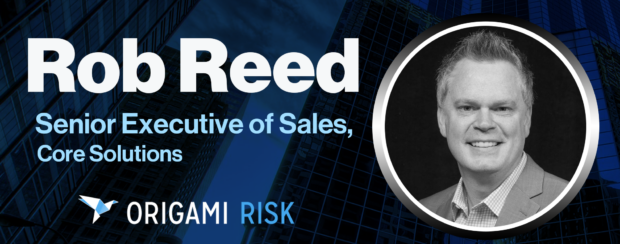Rob Reed is a self-described “insurance devotee, MGA/Insurtech champion, connector of people, and all-around helpful human being,” according to his LinkedIn profile. He has extensive experience in the property and casualty business and the MGA/insurtech space in particular. We recently sat down to talk with Rob about his experience, knowledge, and the insights he brings to Origami Risk clients in his role as a senior sales executive for core solutions.
Q: What attracted you to the P&C insurance technology space?
A: Early in my life, I had a mentor who owned a life insurance agency. I spent a lot of time with him — in his office, listening to his calls, and learning the trade throughout my teenage years. My mentor used to call insurance “a noble profession,” and that encapsulates my own view on the work we do as an industry. After college, I took a job with Prudential P&C as an underwriter trainee, and I’ve been committed ever since. Traveling and meeting with agents was part of my role at Prudential; the technology side of the business got into my blood at OneBeacon, the second stop on my career journey. There I was able to directly assist agencies with agency management systems (AMS) and integrations. Then, a happenstance sidewalk meeting with a neighbor led me to Instec, where I spent 20 years serving in a senior sales role. About two years ago, I joined Origami to help establish a presence in the MGA/Insurtech space.
Q: There’s a lot of talk about architecture as a difference-maker in insurance core processes. What exactly is architecture, and why is it so important?
A: MGAs and insurtechs do not always have the luxury of robust IT departments, nor the accompanying budgets, like their carrier partners. So, when technology is required to solve business challenges, the normal response is to approach MGA-exclusive vendors, most of whom have evolved from agency-centric strategies, to serve this niche market. The challenge is that, in recent years, MGAs have seen their operational challenges mirror those of their carrier partners. This means the usual solutions that have historically served MGAs well can now be considered a competitive disadvantage. Instead, modern software architectures capable of supporting multiple distribution models, products, and constituencies, are required.
To make matters more complex, the convergence of plentiful capital and low technological barriers to entry are inspiring creative entrepreneurialism from the greenfield insurtechs and within the largest MGAs. In effect, nearly everyone is “opportunity spotting” while leveraging technologies never intended for these pursuits!
It is well known that “systems” can stymie even the best-laid business plans. Alternatively, modern systems provide a foundation for operational excellence while also allowing for exploration and innovation. The idea of fast-fail or other experimental approaches to insurance is not possible with outdated code that requires constant customization, on-premises deployments, and subsequent maintenance headaches, nor with hybrid-cloud solutions that make integration and data access challenging. In short, architecture matters.
We saw corroboration for the importance of modern architecture — particularly multitenancy — in the recent Aite-Novarica report “Property/Casualty Policy Administration Systems.” The report notes that acceptance and interest in multitenancy is growing rapidly — a trend Aite-Novarica predicts will continue. In fact, they think it will ultimately become the “new norm.” Origami clients can already attest to why.
Q: What do you say to those still sitting on the fence when it comes to multitenant SaaS platforms?
A: These platforms simply did not exist in the MGA space until recently. Most current MGA-centric vendor solutions are a Frankenstein mash-up of acquisitions and integrations. Also, since MGAs and insurtechs work off an economic model that does not necessarily reward IT investment, it takes visionary leaders — ones who view software as a differentiator for their business — to make an early investment in technologies in order to achieve long-term success.
It is the old “chicken and egg” scenario for most MGA leaders: Do they invest now or later? The biggest risk of investing later is the failure to scale. MGAs and insurtechs have investors and owners, so scaling the business is paramount. The limiting factors of build-your-own and ultra-low-cost solutions are obvious and at times acceptable to achieve early success. But there will come a day when those technological short-cuts and operational workarounds prevent the business from growing at acceptable levels. This is when architecture becomes paramount. Modern SaaS platforms enable employees, enhance productivity, and offer a launch pad for ideation and exploration. Embracing modern software architecture is at the core of future success.
P&C carriers have begun embracing this evolution too, albeit more slowly. Legacy systems complicate ambitions to modernize, which is why a multi-system strategy may initially pay dividends. But the prevailing wisdom is to consolidate, and that is the long play for most insurers. The power of multitenant architecture becomes clear when a large, robust set of prior work efforts become available too. No longer are insurers alone in their implementations. Instead, they can leverage the prior work of hundreds of others to kick-start the solution – a key benefit unique to multitenant solutions.
Q: You also have extensive experience with bureau data. Do you think its integration into today’s modern architecture is as efficient and effective as it could be?
A: Bureau content rates, rules, forms, and statistics is at the core of most insurance products in the US, both admitted and non-admitted. ISO and NCCI content is highly desirable but often considered technologically impossible streamline the connection and deployment across systems. Only a small number of vendors successfully deploy bureau content across multiple insurers. In fact, most specialize in either admitted or non-admitted business. It is a rare vendor that can easily support both.
Future success is linked to the flexibility to leverage bureau content, proprietary content, or some combination of both, and key to this capability are the policy administration solutions in use. Future-proofing your company can be done by selecting modern architecture capable of supporting a product mix that is optimized — whatever the mix of bureau content is.
Q: How does Origami Risk integrate bureau data into its multitenant SaaS platform?
A: Origami’s comprehensive bureau content service differs from competitors’ solutions in two keyways. First, we belong to the bureaus ourselves. We read the circulars, and we process the content in house. Second, we deploy the content within a true multitenant architecture.
Processing ISO and NCCI content gives Origami advantages over the others, particularly in how that content is provided to clients. We have designed a set of services that provide a concierge-like approach to bureau content. We understand the bureaus’ intentions, because we deeply engage with the circular process while navigating our clients’ product strategies. Our bureau insights are shared with clients in advance so that there are no surprises. In fact, we are one of the few software providers to align our bureau content releases with the associated circulars, making ongoing compliance easy. The net effect is that proprietary rates, rules, and forms do not override or interfere with bureau content, and vice versa. Compliance is a central component of our offering, and -we’ve designed a set of services for meeting those requirements.
The architecture of our bureau content repository is unique to the industry. Residing within a multitenant environment, all Origami clients leverage a single database. This provides several benefits. Most importantly it means we have efficiency of scale allowing our efforts to benefit all of our 900+ customers. Our bureau experts can focus on the business of insurance first and foremost. Next, our bureau architecture was designed from the ground-up to enable compliance and product experts to easily navigate, test, and deploy bureau content. Our version key functionalities are novel and offer unmatched self-sufficiency and auditability. When it comes to bureau content, receiving the rates, rules, and forms is not enough. Bureau content is an ongoing process for most insurers, and Origami’s architecture and easy-to-use tools provide a platform that is unmatched today.
To learn more about multitenant SaaS, modern architecture, and incorporating up-to-date bureau content into your MGA or P&C insurance platform, contact Rob Reed at rreed@origamirisk.com or 630-697-8416.





















 Progressive Gains as Drivers Shop Around for Auto Insurance—Again
Progressive Gains as Drivers Shop Around for Auto Insurance—Again  That Insurance Talent Crisis? It’s a Global Knowledge Opportunity
That Insurance Talent Crisis? It’s a Global Knowledge Opportunity  Former MLB Player Charged With Insurance Fraud in Florida
Former MLB Player Charged With Insurance Fraud in Florida  Triple-I: Insurance Economic Drivers Outperform Overall U.S. GDP
Triple-I: Insurance Economic Drivers Outperform Overall U.S. GDP 



